The Acer Nitro 5 Gaming Laptop Review: Absolutely AMD - Ryzen Plus Polaris
by Brett Howse on February 15, 2019 8:30 AM ESTDisplay Analysis
Acer’s Nitro 5 offers a 1920x1080 15.6-inch display which is an IPS panel, which is great to see. Even though this is a value offering, it would have been disappointing to see a TN display, so well done Acer. That is about where the good qualities of this display end, unfortunately.
 Acer Nitro 5 Subpixels with Anti-Glare coating
Acer Nitro 5 Subpixels with Anti-Glare coating
At 15.6-inches in size, the 1920x1080 resolution does allow you to run 100% scaling without the elements getting too small. That’s a benefit for sure, since you won’t get the artifacts that can still existing when using scaling in Windows 10. There’s been a lot of improvements to the OS to correct this, but not all applications have taken the time to ever deal with it. Luckily that won’t be a concern at 100%.
To test the display we use SpectraCal’s CalMAN suite with a custom workflow. Brightness and contrast readings are taken with the X-Rite i1Display Pro colorimeter, and color readings are taken with the X-Rite i1Pro2 spectrophotometer.
Brightness and Contrast
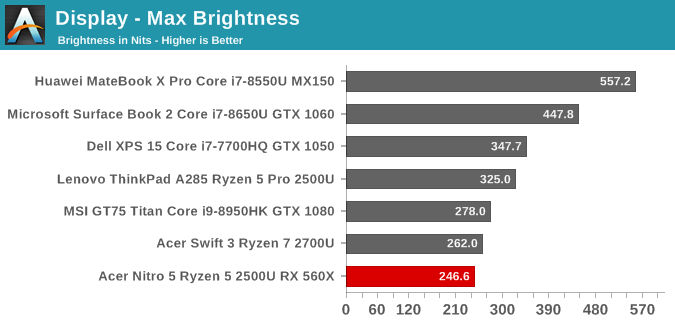
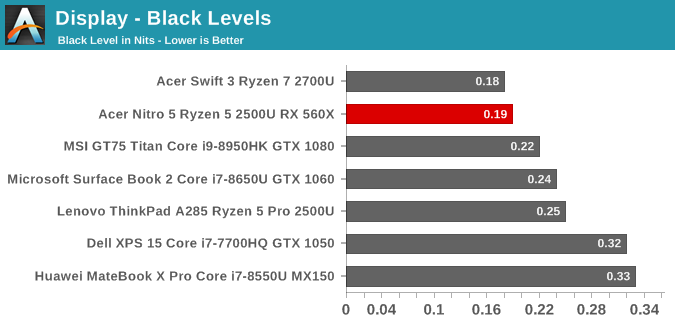
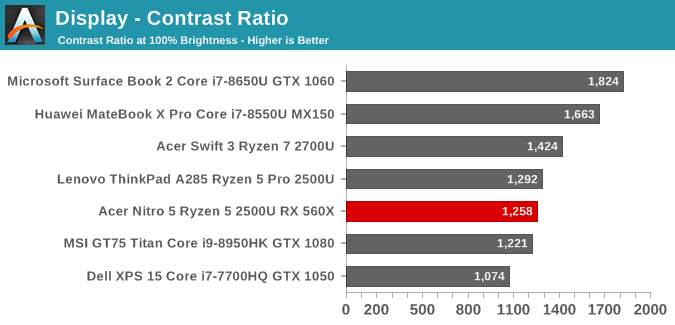
The panel on the Nitro 5 doesn’t get particularly bright, topping out at just 246 nits. It also doesn’t get particularly dark either, with a minimum brightness of 16 nits. But both values are likely fine for use indoors on a desk. The black levels are quite good though, leading to a solid contrast ratio of 1258:1 at maximum brightness.
Grayscale
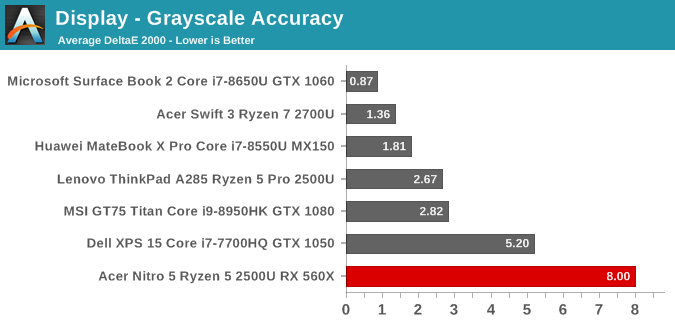
Here is where things start to get unravelled for the Nitro 5. The grayscale accuracy is terrible, thanks to the green part of the backlight being far too bright at almost any point in the range. The gamma curve is also well off the 2.2 value expected, falling increasingly under that point starting at around 35% brightness. This means there will be less of a dynamic range between highs and lows as you go towards greater brightness levels.
Gamut
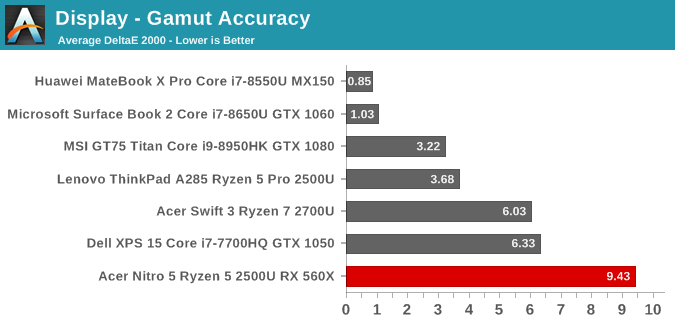
Here we can start to see the problems inherent in this display. The greens are the only colors even close to hitting the sRGB gamut, with red well under and blue doing its best impression of Hawaii. The graph ranges had to be adjusted just to see on the chart how far blue is off the mark, and at almost a dE2000 of 25, it is very, very far from where it should be.
Saturation
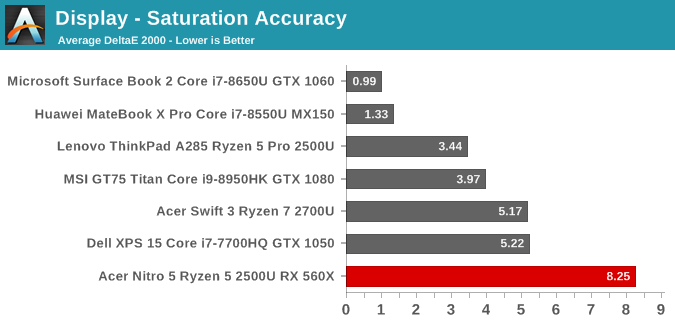
Gamut is the primary and secondary colors at 100% brightness, whereas with the saturation sweep we test with 4-bit steps from 0% to 100%. It’s amazing just how far off the blue levels are, and coupled with the less than amazing reds, the magenta values are also dramatically impacted.
Gretag Macbeth
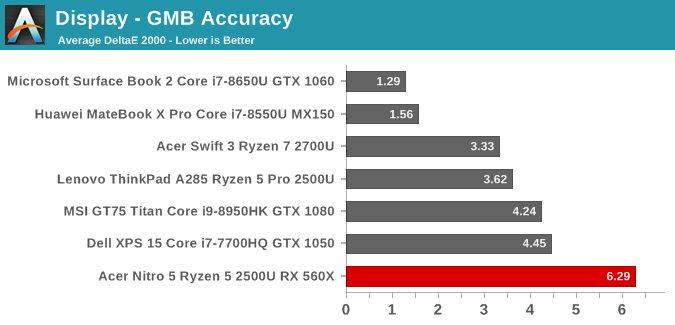
This graph also needed to have almost all of the charts adjusted to show just how far off the mark the colors are on this display. Considering the less than amazing primary colors, it’s no shock that every single color is pretty much terrible.
Colorchecker
This image shows the intended color on the bottom, and the achieved color on the top, so it gives a nice representation of the previous tests. The whites are very green, and the colors are mostly terrible.
Display Conclusion
This display is possibly the least accurate IPS panel we have ever tested. The uncalibrated panel is coupled with a backlight that can’t even come close to covering the entire sRGB spectrum. The Acer Nitro 5 is an entry-level device, and the display is one of the ways they made it to their target price.















90 Comments
View All Comments
RSAUser - Friday, February 15, 2019 - link
Did you try and use the wattman auto undervolt for the graphics card?Does Radeon Chill work for mobile? Then fan noise should go down and battery should last longer.
Testing max fps is bad, don't even have minimum fps, let alone frame time plots to know how smooth it is.
jgraham11 - Friday, February 15, 2019 - link
Wow, did anyone notice that all the other processors are 45Watt meanwhile the AMD chip is only 15W!!! Holy crap!PeachNCream - Friday, February 15, 2019 - link
How can you miss that fact? The differences in TDP were pointed out multiple times in the article. You'd have to be in some serious skim mode to overlook it.cfenton - Saturday, February 16, 2019 - link
From the article: "Being a U series, the TDP is 15-Watts by default, though AMD offers a range of cTDP modes from 12-25 Watts. This is a rarely tapped feature on most laptops, but in this case it looks like Acer has put the Ryzen in cTDP up mode."So the AMD chip is 25w and the Intels are using 35w. It's a difference for sure, but it's not 15w vs 45w.
Brett Howse - Saturday, February 16, 2019 - link
The Intel ones are 45W - the 35W is an optional cTDP down mode.cfenton - Saturday, February 16, 2019 - link
My mistake. Thanks for the clarification.jgraham11 - Saturday, February 16, 2019 - link
For sure I believe you are correct, except for the MSI one which is 45watt.One thing I did find while looking at these specs for these Laptops:
Note all Newegg.com prices except the Acer AMD setup, as I could not find it. Prices are as of Feb 16 2019.
MSI GT75 TITAN GTX 1080 8 GB VRAM i9-8950HK sells for $4958.64
Huawei MateBook X Pro Intel Core i7 8th Gen 8550U MX150 sells for $1449.00
Dell XPS 15 core I7-7700HQ GTX 1050 sells for $1849.55
Microsoft Surface Book 2 Core i7 8650U GTX 1050 sells for $2279.00
This is not an Apples to Apples comparison in the least!
Meanwhile they are comparing it to a $699 AMD laptop....
Do you think that the extra $1k would provide a metal chassis which would result in better overall thermals hence better performance. And a better screen...
Anandtech please compare this one to another Acer Nitro 5 but with an Intel processor to actually make it a fair comparison.
Brett Howse - Saturday, February 16, 2019 - link
I explained why the comparison models were chosen in the review.fmcjw - Sunday, February 17, 2019 - link
Really? You don't take suggestions really well do you? I second jgraham11's suggestion because the thermal design makes each Intel Core a different beast.This is really an amateurish review, you can get as much info from a compact notebookcheck.com analysis. Who needs to be told that "Being a SATA based SSD, peak performance is certainly limited compared to NVMe drives, but it still offers orders of magnitude better performance compared to spinning drives?" Just show it in a table or chart. Are you being paid to hit a certain word count?
And you're unclear on whether adding a second RAM makes it dual channel, nor have you mentioned that you tried to see if Dual Channel is supported, but rather stuck to whatever configuration the company sent you.
Calin - Monday, February 18, 2019 - link
For spinning versus solid state hard drive performance, you have plenty of comparisons - when the transition took place, 5 or so years ago. Today's SATA SSD's aren't so much faster than the champions of 5 years ago (in typical end-user scenarios), but neither have the magnetic hard drive performance improved.